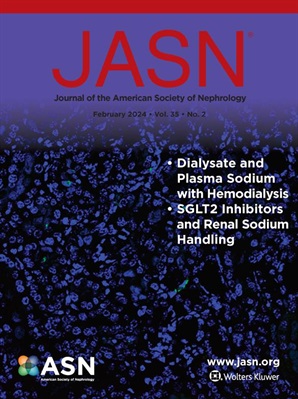肾移植前筛查确定冠状动脉血运重建的1类适应症。
IF 9.4
1区 医学
Q1 UROLOGY & NEPHROLOGY
引用次数: 0
摘要
背景:心血管疾病是肾移植受者发病和死亡的最常见原因。肾移植前通常需要进行冠状动脉疾病筛查,但除了复杂的冠状动脉疾病外,冠状动脉介入治疗并没有显示出有益。发现重大冠状动脉疾病的可能性和常规移植前筛查的益处是不确定的。方法我们进行了系统回顾和荟萃分析。检索Medline和Embase以确定1998年至2024年间发表的报告移植前筛查结果的手稿。主要终点是发现有AHA 1级指征的显著冠状动脉病变的频率:a)左主干狭窄50%;或b)多血管疾病,在肾移植前筛查时射血分数< 35%。次要终点包括发现多支血管疾病的频率、近端左前降支(LAD)疾病的频率和接受有创冠状动脉造影的患者数量。meta回归用于探讨高血压、糖尿病和年龄之间的结果异质性。结果共纳入1273项研究,其中44项符合入选标准。1类适应症的平均患病率为2%,尽管异质性很高,估计从0%到17%不等。估计近端LAD疾病的患病率为2%,左主干狭窄的患病率为1%,而10%的患者患有多支冠状动脉疾病,35%的患者接受了有创血管造影。没有证据表明在人群性别或糖尿病或高血压患病率方面存在显著的异质性。结论在移植前冠状动脉筛查中发现ⅰ类血运重建指征的病例较少。本文章由计算机程序翻译,如有差异,请以英文原文为准。
Class 1 Indications for Coronary Revascularization Identified in Prekidney Transplant Screening.
BACKGROUND
Cardiovascular disease is the most common cause of morbidity and mortality in kidney transplant recipients. Screening for coronary disease is frequently required prior to kidney transplantation, but coronary intervention has not been shown to be beneficial except in complex coronary artery disease. The likelihood of finding significant coronary artery disease and the benefits of routine pre-transplant screening are uncertain.
METHODS
We performed a systematic review and meta-analysis. Medline & Embase were searched to identify manuscripts published between 1998 and 2024 reporting the results of pre-transplant screening. The primary endpoints were the frequency of detecting significant coronary lesions for which there are AHA class 1 indications for revascularization: a) >50% left main stenosis; or b) multi-vessel disease with ejection fraction < 35% during pre-kidney transplant screening. Secondary endpoints included frequency of detecting multivessel disease, proximal left anterior descending artery (LAD) disease, and number of patients who underwent invasive coronary angiography. Meta-regression was used to explore outcome heterogeneity according to the presence of hypertension, diabetes, and age.
RESULTS
We identified 1273 studies out of which 44 met eligibility criteria. The mean prevalence of class 1 indications was 2%, although the heterogeneity was high with estimates ranging from 0% to 17%. Estimated prevalence of proximal LAD disease was 2% and left main stenosis was 1%, whereas 10% of patients had multi-vessel coronary artery disease, and 35% were referred for invasive angiography. There was no evidence of significant heterogeneity according to sex of the population or prevalence of diabetes or hypertension.
CONCLUSIONS
Identification of class I indications for revascularization during pre-transplant coronary screening was rare.
求助全文
通过发布文献求助,成功后即可免费获取论文全文。
去求助
来源期刊
CiteScore
22.40
自引率
2.90%
发文量
492
审稿时长
3-8 weeks
期刊介绍:
The Journal of the American Society of Nephrology (JASN) stands as the preeminent kidney journal globally, offering an exceptional synthesis of cutting-edge basic research, clinical epidemiology, meta-analysis, and relevant editorial content. Representing a comprehensive resource, JASN encompasses clinical research, editorials distilling key findings, perspectives, and timely reviews.
Editorials are skillfully crafted to elucidate the essential insights of the parent article, while JASN actively encourages the submission of Letters to the Editor discussing recently published articles. The reviews featured in JASN are consistently erudite and comprehensive, providing thorough coverage of respective fields. Since its inception in July 1990, JASN has been a monthly publication.
JASN publishes original research reports and editorial content across a spectrum of basic and clinical science relevant to the broad discipline of nephrology. Topics covered include renal cell biology, developmental biology of the kidney, genetics of kidney disease, cell and transport physiology, hemodynamics and vascular regulation, mechanisms of blood pressure regulation, renal immunology, kidney pathology, pathophysiology of kidney diseases, nephrolithiasis, clinical nephrology (including dialysis and transplantation), and hypertension. Furthermore, articles addressing healthcare policy and care delivery issues relevant to nephrology are warmly welcomed.

 求助内容:
求助内容: 应助结果提醒方式:
应助结果提醒方式:


